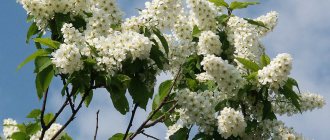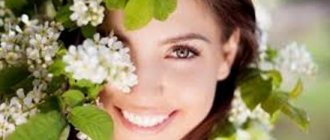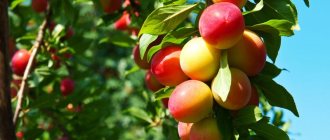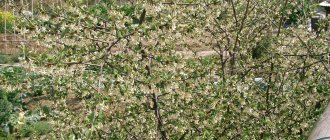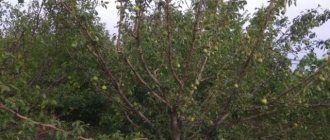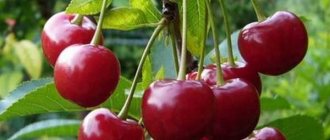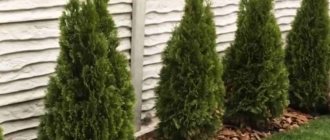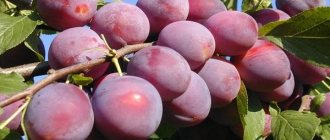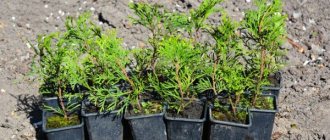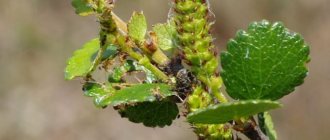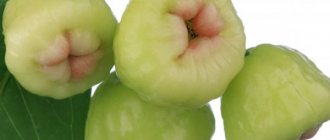Description of Virginia bird cherry
This spreading, wide tree of the Plum genus was brought from North America .
In its homeland it can grow up to 15 m in height, and in garden conditions it usually reaches 5–7 meters. It grows quickly and produces a harvest already in the fourth year after planting. The plant is a close relative of garden trees such as plum and cherry. The tree bark is gray with a purple tint. The bright green, oval-shaped leaves become reddish in autumn, and the young shoots have a dark brown color. White small flowers are collected in elongated racemes. The tree blooms after the leaves appear - in late May or early June, and therefore is not subject to the harmful effects of spring frosts. Beautiful abundant flowering, which lasts for two weeks, is not accompanied by a sharp characteristic odor inherent in common bird cherry trees. The round fruits begin to ripen in August and have a bright or dark red color . The fruits do not fall off, and if they are not collected, the tree can be decorated with them in winter almost until spring.
Varieties of red bird cherry
The following varieties are popular in our country:
- Bird cherry Virginian Schubert is a tall ornamental plant with a beautiful crown. The leaves can be green or red with a purple tint. Edible ripe fruits are dark red, almost black. This variety is resistant to garden pests.
- Bird cherry Canada Red has a conical crown shape. The leaves acquire a reddish tint already at the beginning of summer. Black shiny fruits have an astringent taste. This variety is characterized by frost resistance.
Popular varieties of red bird cherry
The Schubert variety is considered the most common for growing in private plots. This red bird cherry with glossy leaf blades has decorative properties and is often planted as a garden decoration rather than for picking berries. The plant reaches a height of 6–10 meters, with age it develops a lush, spreading crown, which changes color depending on the season: in summer the leaves are green, and by autumn they acquire a purple or violet hue.
An equally popular variety is Canada Red, a tree reaching a height of 5 meters and having a conical crown shape. At the very beginning of the growing season, the leaves are green, but with the arrival of summer they turn red-violet.
Both varieties are undemanding to the composition of the soil, however, on a fertile piece of land their decorative qualities are revealed more clearly. The juiciness of the berries largely depends on the illumination of the planting site and the regularity of watering.
Planting red bird cherry on the site
The red-leaved plant will be a real decoration of the garden if you place it in a lighted area, but even in the shade the tree grows well and retains the color of the leaves. The most suitable for planting is the western or northern side of the land . Moist, fertile soil is considered ideal for growing a healthy, beautiful plant. When choosing a location, you should avoid lowlands so as not to expose the flowers to damage during spring frosts. It must be taken into account that the tree grows quickly and acquires a wide crown, which can shade nearby shrubs or flowers.
Virginia bird cherry reproduces in different ways:
- seedlings from seeds;
- cuttings;
- root shoots;
- layering.
To obtain seedlings, seeds taken from ripe fruits are placed in holes 5 to 6 cm deep. Grown-up rooted plants are planted in spring or autumn to a depth of 50 cm, so that the roots are completely covered, in holes about 70 cm wide. The distance between trees should be about 4 meters. After planting, the soil around the seedling should be mulched with sawdust or peat.
Planting Virginia bird cherry
Bird cherry planting activities begin in spring or autumn during the period of vegetative dormancy of plants. To grow trees for harvesting, varietal seedlings are purchased from nurseries or from trusted individuals.
Before purchasing, it is important to inspect the plants for signs of disease or rot. Firstly, this will protect you from purchasing non-viable planting material, and secondly, it will protect your garden plot from possible infection. The root shoots of the seedling should be elastic and flexible - this indicates their health and proper storage.
After the young bird cherry is brought home, its rhizome should be placed for half an hour in a container with a root formation stimulator diluted in water, such as Kornevin or Epin. This will help the plant quickly adapt and take root in a new place.
All weak root shoots can be trimmed. In addition, before planting, the stems of the seedling are also cut off, leaving only the 3 strongest and most promising ones - they are shortened to 60–80 centimeters.
Choosing a place for a tree or fruit bush is always a very responsible matter. Since bird cherry loves moisture and in natural conditions often grows on the banks of reservoirs, it is necessary to assign it land with shallow groundwater, in a lowland or in an area that is most abundantly watered during the summer.
The area for growing this crop should be spacious and well lit. Both the decorative qualities of bird cherry and the taste properties of the berries depend on this. With insufficient sunlight, the fruits become smaller and ripen only on the uppermost branches. The crown, in turn, will tend to grow without developing lateral branches.
So, when the optimal solution regarding the choice of landing site has been found, the immediate preparation of the landing pit can begin. It is dug in accordance with the size of the root system of the seedling, but its depth and sides should not be less than half a meter.
When planting fruit bushes and trees, drainage from broken bricks or crushed stone is always laid as the bottom layer; this will protect the plants from rotting roots. The second step is to pour out a soil mixture of garden soil, peat and humus. The hole prepared in this way is watered generously and left to shrink for at least a day or two.
After the specified time, a small mound of fertile soil is formed in the hole, on which the bird cherry seedling is carefully placed. Root shoots should be distributed along the steep edges of the elevation, avoiding their kinks and damage. The remaining volume of the pit is gradually filled with soil, which must be compacted to avoid the formation of air bubbles.
Upon completion of the planting procedure, the plant is watered abundantly, a tree trunk circle is formed around it, which is mulched with sawdust or peat to retain moisture on the surface of the earth.
Features of care
Compared to other garden crops, bird cherry is quite unpretentious . However, there are simple rules of care that will allow you to grow a beautiful tree and get the expected harvest.
- Watering . The moisture-resistant soil chosen for planting needs watering several times a year. In hot and dry summer weather, it is advisable to water weekly.
- Feeding . In the autumn, it is necessary to add manure or wood ash to the soil. In early spring, before the leaves appear, the tree should be fed with liquid mineral fertilizers.
- Soil care . After rain, it is recommended to loosen the soil to prevent the formation of a crust, which prevents the penetration of oxygen to the roots. In summer, the soil should be periodically dug up and weeds that inhibit the root system should be removed.
- Trimming . Due to the active growth and branching of the crown, the tree needs regular formative pruning. Once a year it is recommended to trim the main shoot by 0.5 m to create a beautiful shape. It is advisable to thin out a crown that is too lush. Garden varnish is used to coat cut branches.
- Harvesting . Only ripe dark fruits should be collected using dry, clean containers. In a cool room, the harvest can be stored for about two weeks.
Aftercare
During the dry season, red-leaved bird cherry needs to be watered weekly, especially for young plants. The circle around the trunk is periodically loosened, removing weeds. It is better to tie seedlings with a thin main trunk to a support, which will prevent them from breaking off due to strong gusts of wind. In the fall, wood ash and manure are added to the soil; in the spring, before the buds open, the bird cherry is fed with liquid mineral fertilizer.
Due to the rapid growth rate, all varieties of red-leaved bird cherry require formative pruning. Once a year (in early spring before the start of sap flow or late autumn), the main shoot is shortened by 50 cm, branches growing inside the crown, as well as dry and damaged fragments are removed. The cut areas are treated with garden varnish.
To protect against rodents, sawdust, peat or ash soaked in creolin are scattered under the tree. For the same purpose, in late autumn, after the end of leaf fall, the trunk is tied with spruce branches, wormwood or reeds. It is equally effective to wrap the base of the tree with roofing felt, matting or metal mesh.
Red-leaved bird cherry is a frost-resistant crop that does not require shelter for the winter. Only in the first year after planting is it advisable to cover the circle around the trunk with a layer of humus or cow manure; it will prevent the roots from freezing.
Pest protection
The plant is quite resistant to diseases and pests .
However, the tree is most vulnerable to its main enemy - the bird cherry moth. In order to prevent the negative effects of moths, in early spring, plants are treated with tobacco infusion, lavender infusion or soap solution. To get rid of emerging insects, an effective way is to spray with chemicals, for example, karbofos or the Aktara insecticide. Usually it is enough to spray twice. A marsupial fungus may appear on a tree. This disease cannot be treated, so the affected areas will have to be removed.
Weak plants with cracks or cuts in the trunk and branches are susceptible to fusarium wilt or fusarium blight. Therefore, to prevent drying out, timely pruning and treatment of mechanically damaged areas is necessary.
Beneficial properties of virginiana bird cherry fruits
The fruits of red cherry have a sweet and sour taste and contain:
- sugar;
- organic acids (malic, citric);
- tannins, which impart tanning properties and a slight astringent flavor;
- oil in the pits.
Thanks to these substances, the fruits are consumed fresh and also used to prepare various culinary dishes.
The fruits make delicious, beautifully colored jam. Compotes with the addition of bird cherry have a rich color and pleasant aroma. You can make wine or liqueur with a unique taste. Not only the fruits, but also the leaves, bark or flowers of the tree are used for medicinal purposes. Dried berries are suitable for making drinks that can be taken for colds and coughs. Flower decoction is good for washing wounds and ulcers.
Important! It should be remembered that unripe fruits should not be eaten, as they are poisonous. In addition, this plant is contraindicated for pregnant and lactating women. It should be used with caution by those who are prone to constipation. In people with allergies, bird cherry can cause an undesirable reaction.
Gardeners plant red-leaved trees on plots not only to produce a harvest, but also to create beautiful compositions and hedges. The plant in the form of a shrub is used both in landscape design and to strengthen the soil. Red bird cherry can be placed in the garden separately or in a group with other types of bird cherry. In this case, crossing will occur, as a result of which the hybrid will have intermediate characteristics.
Use in cooking
Like any tasty berries, red cherry can be dried, frozen, made into jam, compotes and preparations for filling pies. But it's important to do it right.
Berries should be dried directly on the clusters - if they are picked by tearing them off the stalk, they will quickly lose their shape.
- The collected berries should be spread evenly on a baking sheet and placed in an oven heated to 40-50 degrees.
- After 1 hour, the temperature should be increased to 80-90 degrees, the oven should be opened periodically for 10-15 minutes.
- When the fruits have noticeably withered, the degrees are reduced to 20-25 and drying continues until dried fruits are obtained.
- Then they are freed from the stalks, placed in glass jars with a tight lid and stored in a cool place.
These berries can be used to make compotes in winter, as well as make flour for original baking.
Compotes made from red bird cherry are tasty and healthy. Closing them is simple - for 1 kilogram of berries you need to take one and a half liters of water and 250-300 grams of sugar.
The berries are washed, filled with water, and sugar is added. The mixture is brought to a boil, boiled for 10 minutes, poured into jars and sealed with sterilized lids. The jars are placed upside down, wrapped and left for 2-3 days until they cool down. Then they are sent to a dark, cool place until consumed.
Experts recommend not covering the compote with berries - it is better to strain it before pouring it into jars.
You can also preserve red bird cherry in the form of jam. It turns out aromatic, tasty and healthy, rich ruby color.
The berries are washed, then dipped in boiling water for 2-3 minutes - blanched. Then sugar is added to the water where the berries were boiled (1:1 by weight of the fruit). The mixture is boiled to the desired consistency, poured into jars and rolled up. The jars are placed upside down and wrapped, standing there until they cool completely. Then they are sent to the storage location.
You can not only prepare berries for the winter, but also enjoy them during the season, not only fresh. If you blanch the fruits and then grind them with sugar (for 500 g of berries - 300 g of sugar) you will get a wonderful pie filling.
You can make the dough yourself or buy it ready-made. It should be rolled out, placed on a greased baking sheet, and the filling should be placed on top. Just half an hour - and the delicious aromatic pie is ready. The temperature should be 180-200 degrees. You can make a lattice of dough strips on top.
Decorative red-leaved bird cherry for decorating a summer cottage
The diversity of plants on earth allows you to create incredibly beautiful landscapes in parks and country houses. Red-leaved bird cherry is widely used for contrasting and unusual compositions. The bright color of the foliage and the pyramidal crown of the tree stand out elegantly against the backdrop of the lush greenery of the garden. North America is considered the birthplace of the plant. There it is found almost everywhere. In the middle of the 17th century, Europeans became acquainted with the culture and appreciated its beauty. In addition, red-leaved bird cherry has a number of beneficial properties. Its bark and black fruits are used to treat various ailments. What does this overseas beauty look like? What do you need to know to grow such a tree on your property? How to properly care for decorative bird cherry? Let's find out the answers to these questions.
Bird cherry Colorata in landscape design
This is a fairly large tree, so it is most often used in single (solitary) plantings.
The plant looks beautiful: next to the house, against the background of a well-groomed lawn, on the border of the garden (in rows)
Red-leaved bird cherry Colorata looks especially impressive on the shores of reservoirs, on the edges, against the backdrop of large trees.
The tree is planted in alleys for zoning the site
Red-leaved bird cherry in all its glory
The concept of “white crow” allows us to imagine the bright contrast of something that stands out against a gray background.
Likewise, bird cherry with purple foliage attracts special attention. The plant is often called a “chameleon” for its ability to change leaf color throughout the season. In early spring, the plates are no different from other trees on the site. However, at the beginning of July an original metamorphosis occurs. The pyramidal crown of the red-leaved bird cherry takes on a purple hue, and it becomes the queen of the garden. The tree lives about 70 years. The maximum height of an adult crop is approximately 7 m. Over the course of a year, the plant grows in height by approximately 1 m. Due to this, it is actively used to form exotic landscapes.
During the flowering period, bird cherry puts on a chic outfit of many snow-white or pinkish buds. Some of them are about 15 cm in diameter. They emit an intoxicating scent that creates an aura of bliss around them.
Large bird cherry berries with red leaves have a sweet taste. They are easy to remove from the branches. Thanks to the strong peel, the fruits do not release juice, so they can be stored for several days. Used in folk medicine. The first fruits appear already in the third year after planting. During the season, from 20 to 40 kg of berries are collected from an adult tree.
The culture has a stable root system. Thanks to this, it will grow successfully even on dry and depleted soil. Perfectly withstands winter cold and summer heat. There are many varieties that decorate the gardens of our compatriots. Let's get to know some of them.
Gorgeous Siberian beauty
The plant grows to approximately 5 m in height. It has a lush pyramidal crown shape. Young bird cherry foliage is painted a soft green color. As it ages, it becomes a deep purple color. The lower part of the plate has a light purple tint.
When the flowering period begins, many snow-white bouquets appear on the Siberian beauty.
During this period, there is a strong aroma around the tree that attracts hundreds of insects. Over time, small fruits set. At first they are colored green, then red, and when ripe they become black. The red-leaved bird cherry Siberian beauty shown in the photo evokes the admiration of many gardeners. If you plant several of these plants on a plot, you can significantly increase the crop yield.
Exquisite Red Tent
The variety is a tree, about 4 m high with an ellipse-shaped crown. At the beginning of spring, green oval leaves bloom on it. By mid-summer they turn purple. The Red Tent blooms in May with lush fragrant clusters. The black ripe fruits are covered with a glossy skin and have a pleasant taste. The culture wonderfully tolerates summer heat and winter frosts.
Her Majesty the Bird Cherry Unkilled
The variety belongs to tall crops and reaches 7 m in height.
The shoots of the plant are covered with dense foliage and are colored dark brown. They form an oval crown, which during flowering puts on a snow-white outfit of fragrant brushes. In mid-July the foliage completely changes color. At first it turns red, and then turns into a rich plum shade.
Interestingly, the culture received its name in honor of the last emperor of Russia, who was executed in the middle of summer. It is at this time that the bird cherry leaves turn bloody red.
Having looked at the detailed description of red-leaved bird cherry, wouldn’t you want to grow such a plant? Let's figure out how to make your dream come true.
Bird cherry in Siberia: varieties, diseases and pests
In the Central Siberian Botanical Garden (CSBS), work with bird cherry trees began a long time ago, when the first virginian bird cherry hybrids were obtained. Bird cherry is interesting both as a fruit crop and as an ornamental one. Currently, 9 edible varieties of bird cherry and 6 ornamental varieties are registered under the authorship of CSBS.
In the breeding of bird cherry, the main emphasis was placed on obtaining hybrids of virgin bird cherry and common bird cherry (carpal). The first variety bred at TsSBS was named in Memory of Salamatov - in honor of the scientist who studied and selected the bird cherry crop. The fruits of this variety reach a weight of 0.9-1.0 g, have decent taste, and the variety bears fruit consistently.
Description of bird cherry
Bird cherry is one of the most winter-hardy of the stone fruit plants. It can withstand almost any frost that occurs in the harsh West Siberian climate.
Bird cherry is not afraid of freezing; its wood is absolutely resistant to frost, withstanding up to 50 °C. The vast majority of different types and forms of bird cherry do not freeze and are completely winter-hardy.
However, bird cherry is very vulnerable to any frost in the state of loose buds and flowers. During this period, it is more unstable than apple, cherry, plum and other similar crops. The ovaries are damaged and fruits are not formed.
Bird cherry is a cross-pollinated crop; for pollination it needs insects and good weather conditions. For bird cherry, return frosts in May are not as dangerous as rainy, cool weather when there is no summer of insects. If there is poor pollination on the bird cherry tree, then there will be no harvest.
Therefore, when choosing a bird cherry variety, it is so important to take into account the timing of its flowering. It is good for Siberia if the bird cherry blossoms at a later date. According to observations, an adult tree (7-8 years old and older) produces a good harvest of 20 to 40 kg of fruit. If the harvest is poor, bird cherry will produce 10-12 kg. It begins to bear fruit 3 years after planting.
Where to buy bird cherry seedlings
Bird cherry seedlings, including new and improved hybrids and varieties, can be purchased at the Central Siberian Botanical Garden (Novosibirsk). The new generation of hybrids has a wide choice of flavors and fruit weight is 20-30% greater than that of existing varieties.
Decorative bird cherry
The main properties of decorative bird cherry:
- — high winter hardiness;
- - regular flowering (even during frosts);
- - original color of flowers and leaves.
Bird cherry varieties
The most interesting hybrids and varieties are obtained from crossing various forms of bird cherry: the Colorado variety with intensely colored leaves and pinkish-lilac flowers, the common bird cherry variety with soft pink blooms, a sample of virginian bird cherry from America, the color of the leaves of which changes during the season from light green to purple-red.
The varieties bred at TsSBS based on the above samples differ from each other in crown shape and growth vigor. Usually the bird cherry tree reaches a height of 6-8 m. If you want it to be lower, you need to shape the crown accordingly and carry out regular pruning in height. You can create the crown shape you like. This is achieved by appropriate pruning, bending and tying the branches so that they do not grow upward, but to the sides.
The Purpurnaya bird cherry variety is distinguished by the shape of its crown - it is narrow pyramidal and resembles a candle.
The bird cherry variety Siberian Beauty is the tallest. Its crown is quite wide.
The bird cherry variety Red Tent can be used as a food variety - it blooms intensely and bears fruit abundantly, provided there is sufficient pollination. The variety has a wider crown, but the color intensity is slightly less.
The Slender bird cherry variety is distinguished by its bright summer-autumn red foliage and pale pink flowers.
The bird cherry variety Cloud stands out for its lush white flowers. If the common bird cherry has a flower diameter of 16-17 mm, the flowers of the Cloud reach a diameter of 26 mm. Very large flowers and fruits, but does not have a large harvest.
Bird cherry varieties Red season are the most original variety in its decorativeness. It combines the red foliage of the Colorado variety and the Virginia Schubert cherry variety. Intense leaf color is observed throughout the season: red leaves and pinkish-lilac flowers, then the plant begins to turn slightly green, then again acquires a purple color, and this continues until the end of the season. A weak-growing variety, it will grow up to 3-4 m in height.
Diseases and pests of bird cherry
Bird cherry is unlucky - many amateur gardeners consider it a breeding ground for diseases and pests, as if aphids move from it to other plants. There are quite simple and effective control measures against all these pests: manual collection, agrotechnical prevention methods, and the use of effective pesticides.
Aphid on bird cherry
Bird cherry is really affected by aphids, just like other plants in the garden. But the aphid on bird cherry is a separate species of aphid (and there are a lot of them in nature), which does not even think of moving to other plants. Aphids appear on bird cherry trees quite early, which is why it is believed that the annoying pest comes from the bird cherry tree to feast on other crops.
In my experience of working with bird cherry more than 40 times, I can safely say that during all this time, aphids on bird cherry have intensively colonized 5 times, no more. Therefore, aphids on bird cherry trees are still not common.
Bugs on bird cherry
For edible cherries, bugs are a big problem. However, if there is no large area of plantings, and the site is located in an open area, you don’t have to be afraid of bedbugs.
Plant bugs attack young bird cherry fruits in large numbers, sucking the juices out of them. As a result, the berries have neither size nor taste, they simply fall off.
Weevil on bird cherry
The bird cherry weevil lays a fertilized egg in each young bird cherry fruit, a larva hatches from it, and the larva begins to eat the seed. The seed sets the development program for the fruit, so if the seed is eaten, the fruit quickly collapses or turns out small and sour.
The bird cherry weevil can also attack cherries.
Hawthorn on bird cherry
Of the pests, the hawthorn is the most annoying to the bird cherry. At the same time, the hawthorn only harms the bird cherry and does not creep onto other trees and shrubs in the garden.
Hawthorn is a large white butterfly with black streaks on its leaves. Her mass year begins in mid-June. At this time, she lays eggs on leaves in groups of several dozen. They hatch into small (about 1 cm or less in length), but voracious caterpillars. They gnaw the leaves, roll them up, and go to bed. At this time, they do not cause much harm, besides the fact that the aesthetic properties of the plant are noticeably reduced. The leaves on the bird cherry tree simply dry out, and the caterpillar nests hang on the cobwebs.
Hawthorn caterpillars spend the winter in these nests, and in the spring they come out of their hibernation, begin to grow quickly and eat everything green - leaves, flowers, buds. A fairly large caterpillar, 3-4 cm long, grows, then it quickly pupates and butterflies hatch immediately.
The fight against hawthorn on bird cherry is very simple, no chemicals are needed. In the fall, you need to collect all the nests and burn them. On the other hand, collecting all the caterpillars from a large, tall plant is not so easy. Therefore, you need to shape the bird cherry so as to reach the highest branches.
If you were unable to collect and burn everything, in the spring, when the caterpillars emerge from their nests, you need to treat the bird cherry with chemicals - insecticides. Spraying is usually carried out 2 weeks before flowering.
Bird cherry moniliosis
Bird cherry is susceptible to some fungal diseases - moniliosis or gray rot, which appears on leaves and inflorescences in the spring. The disease is more common than the mass spread of aphids. When bird cherry is infected with moniliosis, its young shoots, tassels with flowers and set fruits begin to sag and dry out. At the same time, you need to understand that moniliosis is a group of diseases, and the species name of the pathogen differs for different crops. Thus, cherries, for example, have a different causative agent of moniliosis, they do not exchange with each other, the diseases are specific.
Why does bird cherry give you a headache?
If you place a large, beautiful bouquet of bird cherry trees in a room and close the windows tightly, you will wake up with a headache. Therefore, it is better not to place large bird cherry bouquets in a small room, and to ventilate the home more often. At the same time, people have different sensitivity to phytoncides: what some may not feel is a serious problem for others.
Bird cherry produces quite a lot of substances with high physiological activity. If the concentration of secreted substances is high, unpleasant physiological sensations (headache) appear, but there is nothing dangerous about it.
There are other plants related to bird cherry, in which this same property is much more pronounced. For example, Pennsylvania cherry. If you put it in a bouquet in a room, a terrible headache is guaranteed. Magolep cherry, which grows in more southern and warmer places, has an even more pronounced aroma.
Secrets of planting and caring for crops
Despite its bright attractiveness, red-leaved bird cherry takes root wonderfully in different types of soil.
However, to achieve a special decorative effect, it needs fertile soil. When choosing a planting site, several factors should be taken into account. It should be:
- quite spacious;
- away from tall plants;
- protected from drafts;
- have plenty of sunlight.
For example, if bird cherry is planted in the shade, it will bloom and bear fruit sparingly. Isn't it better to follow the recommendations of experts?
The plant is planted in early spring or mid-autumn. First, carefully examine the root system and remove weak parts.
Then they begin planting and caring for red-leaved bird cherry, which consists of the following actions:
- dig a funnel 0.5 m deep, 0.7 m wide;
- Fertilizer is poured onto the bottom;
- lay the seedling, straightening the roots;
- sprinkle with soil;
- water generously;
- mulch with sawdust or peat.
In order for the tree to develop successfully, it is watered every week during the dry period. At the same time, the area around the trunk is regularly weeded. In the fall, the soil is fed with wood ash and humus, and in the spring with liquid fertilizers. Once a year, the crown of the bird cherry tree is trimmed, giving it a beautiful shape. Thanks to this, the plant always has an attractive appearance on the territory of the summer cottage.
Description and use of an unusual variety of bird cherry, Colorata
Bird cherry has been grown in Russia for a long time.
This tree is famous for its beautiful appearance and unique aroma during flowering. Various parts of this plant have medicinal properties. Therefore, they are often used in folk medicine; they can best influence human health. The Colorata variety (or also called Virginia Schubert) is highly popular and boasts not only its appearance, but also delicious fruits.
The bird cherry variety Colorata was developed in Sweden. It is highly popular among Russian gardeners. This is due to the fact that its characteristics are at the highest level. The young tree grows and develops quickly. Fruit ripening occurs in late July - early August.
Colorata is an ornamental variety with red flowers and green leaves, capable of decorating any garden plot with its appearance. This is not a bush.
This bird cherry tree looks especially good near the shore of a lake or pond. Due to its high winter hardiness, such a tree can be grown in any region of Russia. With proper care, Colorata produces a high, annual harvest.
The variety is also partially self-fertile.
Bird cherry Colorata is a tall tree (5-6 meters) with a dense, ovoid crown. The bark and shoots of the tree are painted in an unusual purple color, and there are both light and dark shades. Young leaves are similar in color to the shoots, and at a more mature age they become bronze-green.
Inflorescences are usually collected in racemes. Bird cherry flowers are very beautiful and fragrant, colored light pink. It is thanks to them that culture is used in landscape design to create various compositions.
The berries of the Colorata bird cherry are edible, have a pleasant, tart taste, are black in color when ripe, and the skin of the fruit is shiny and glossy.
Blooming bird cherry Colorata in a summer cottage
- Bird cherry Colorata is a fairly unpretentious tree and requires much less care than other crops growing in the garden;
- the beautiful appearance of bird cherry and its aroma during flowering can brighten up any, even the most dull, area;
- the tree also tolerates frost and drought well, which allows it to be grown in any region;
- The berries of this variety are edible and quite tasty, which allows them to be successfully used for various types of processing.
And now the cons:
- the tree has low resistance to pest attacks and requires constant preventive measures;
- Colorata also takes up a lot of space, which makes growing a tree in a small area impossible.
Planting time often depends on the location of the garden plot. In the southern and central region, the Moscow region, autumn planting, which takes place in September, will be preferable.
Residents of the northern regions, the Urals and Siberia are recommended to carry out this procedure in late March - early April.
Branches with pink Colorata bird cherry flowers
Choosing a place for bird cherry with red flowers
- Cherry is an unpretentious crop and can grow on almost any soil. But it is best to plant a tree on loamy soil with a neutral or slightly acidic reaction;
- If there is only acidic soil on the site, it must first be limed using lime or dolomite flour;
- You cannot plant bird cherry in places with high groundwater levels;
- Another prerequisite is the presence of sunlight; growing in the shade may not have the best effect on the health of the tree.
Preparation of seedlings
Before planting a small tree, it must be prepared for this procedure and perform the following steps:
- seedlings with an open root system are released for 8-10 hours and soaked in a solution with a growth stimulator. An example of such a drug would be Kornevin, Epin, etc.;
- seedlings with a closed root system are soaked for 20-30 minutes;
- Also, before planting, it is necessary to check the condition of the seedling and remove all dry and damaged branches;
- The same procedure is carried out with the roots of the seedling; in any case, each root will need to be trimmed a little.
Flowering bird cherry Colorata
Preparing the planting hole
The planting hole must be prepared in advance to make the soil more fertile and nutritious. For spring planting, the pit is prepared in the fall, and for autumn planting, it takes about 2-3 weeks. The depth and diameter of the hole should directly depend on the root system of the seedling. Most often, these figures are 40-50 centimeters.
When preparing the hole, the top 20 centimeters of soil is mixed with:
- a bucket of peat;
- a bucket of humus or rotted manure;
- a bucket of sand;
- 80-100 grams of mineral fertilizer.
The resulting mixture is poured into the hole and left to infuse until planting.
Experienced gardeners recommend planting bird cherry trees at a distance of 2 meters from each other. In this case, it is best to place several trees of different varieties on the site so that they can cross-pollinate.
Bird cherry is planted using the following technology:
- the seedling is placed in a hole so that the root collar is 1-2 centimeters above the soil level;
- it is also necessary to carefully straighten the roots;
- then the hole is filled with soil, while periodically shaking the seedling to avoid the formation of air pockets;
- At the end of the work, the tree trunk circle is thoroughly watered and mulched with compost or humus.
Bird cherry seedlings Colorata for sale
Immediately after planting, it is necessary to trim the tree so that its height is 60-70 centimeters, and remove all side branches, leaving the 4 most developed shoots. This procedure will have a beneficial effect on the formation of the bird cherry crown. Next year, in this way it will be necessary to form the second tier, then the third, etc.
In the first month after planting a seedling with an open root system, it must be thoroughly watered.
Colorata bird cherry tolerates drought well, but timely application of moisture will help improve the health of the tree.
A mandatory procedure is regular loosening of the tree trunk circle and removal of weeds.
In order to avoid the development of diseases and the proliferation of bacteria, sanitary pruning is carried out in early spring (immediately after the snow melts) and late autumn (after leaf fall).
During this procedure, dry, frozen or damaged branches are removed. In adulthood, thinning pruning is necessary.
It is also necessary to carefully monitor the direction of shoot growth and promptly trim branches growing inside the crown.
For the first 2-3 years, the tree does not need to be fed; it will have enough nutrients added during planting.
Then the bird cherry is fertilized 2 times a year. Compared to other crops, bird cherry does not necessarily require heavy fertilizing. This feature is associated with the powerful and developed root system of the tree, which can exist independently and obtain the necessary nutrients for itself. Experienced gardeners recommend carrying out the following work:
- In the spring, before flowering begins, complex mineral fertilizers are scattered in the root zone, then the bird cherry must be thoroughly watered so that the product dissolves and can properly affect the health of the tree;
If you perform these steps immediately after rain, you do not need to water the soil.
- In the fall, humus or rotted manure is added to the digging. If the soil on the site is fertile, then such fertilizing can be done once every two years.
Colorata bird cherry blossom in front of the house
| Diseases | Pests |
| Bird cherry Colorata has excellent resistance to many diseases, except fungal ones. Therefore, most often you can find gray rot of inflorescences, clasterosporia, plum pockets, cytosporosis and powdery mildew. | Because of its bright aroma, bird cherry is very popular among pests, especially weevils, bedbugs, moths, hawthorn and gypsy moth. |
| To get rid of the disease, it is necessary to remove and burn all damaged parts of the tree. Treatment with special chemicals that are sold in garden stores can also speed up the healing process. | Getting rid of pests is quite difficult, and sometimes even impossible, the only measure is treatment with chemicals. |
| To prevent fungal diseases, experienced gardeners recommend spraying the tree with soap solution or ash every spring. It is also necessary to carry out sanitary pruning in a timely manner. | It is best to carry out preventive treatments several times a season with infusions of tobacco, nightshade or Karbofos. Another effective measure would be to make traps that hang on a tree trunk. |
The first treatment should be carried out before buds open.
Bird cherry is a very beautiful tree, which also bears unusual, tart fruits and has many healing properties. The Colorata variety is perfect for Russia; it is not picky about the soil or climate, and also does not require complex care.
Source: https://profermu.com/sad/derevia/cheremuha/kolorata.html
Description of red-leaved bird cherry
Bird cherry with red leaves is an ornamental crop that is loved by many gardeners both in Russia and abroad. The tree is characterized by high growth rates, with an average annual increase in height of about 1 m. Adult specimens reach 5-7 m. The crown of the red-leaved bird cherry has a pyramidal shape, but is easily amenable to decorative pruning.
Redleaf cherry is often called the "chameleon tree" due to the unique feature of its leaves changing color throughout the summer season. In spring, green leaves bloom on the branches, no different in color from the rest of the trees in the garden. But at the end of June the picture changes - the crown of the red-leaved bird cherry takes on a dark burgundy or wine hue. The metamorphosis does not end there - new growths form green foliage. Thus, the tree takes on an even more decorative appearance.
Varietal characteristics
The characteristics of red-leaved bird cherry varieties are largely similar. The most important parameters that you should pay attention to when choosing a variety are:
- frost resistance;
- yield and fruiting time;
- precociousness;
- self-fertility;
- resistance to pests and diseases.
Drought resistance, frost resistance
Red-leaved bird cherry is characterized by increased winter hardiness. It can be successfully grown even in regions where the temperature in the winter months drops below 45-50°C. Only fragile seedlings need shelter. During periods of prolonged drought, bird cherry requires additional watering every 7-10 days. In normal times, it is enough to water 3-4 times per season in the first year.
Productivity and fruiting
Red-leaved bird cherry berries ripen in July and can remain on the clusters until autumn. One tree, depending on the variety, can produce an average of 10-20 kg of berries. The fruits bake little in the sun; this only happens in very hot, dry summers. Unlike ordinary bird cherry, the berries of red-leaved varieties are larger and sweeter, without viscosity or sourness. They are used in cooking in the preparation of compotes, jams, and various tinctures.
Resistance to diseases and pests
Red leaf bird cherry can suffer from diseases such as:
- moniliosis;
- Clusterosporiosis;
- cytosporosis;
- red spot.
Among the pests on red-leaved bird cherry you can most often find aphids, bugs, hawthorn, and weevils.
The degree of susceptibility to a particular disease depends on the specific variety and agricultural technology. Weak and depleted plants are affected by pests many times more often than strong and healthy ones.
Description of Colorata bird cherry and characteristics
Bird cherry Colorata is a fairly large tree (less commonly an ornamental shrub) with a height of 10 to 15 m. A characteristic difference of the variety is the anthocyanin (red-violet) color of the leaves, petals, even the bark and part of the wood.
The crown of the Colorata bird cherry is oval at first, then becomes round and spreads out to the sides. The plant produces a lot of shoots. The bark is smooth to the touch, with lentils that give a pleasant aroma. At the same time, young shoots are painted wine-red or olive in color. The root system is of a superficial type, well developed, dense, produces many shoots and shoots emerging from the stump.
The tree does not grow very quickly (compared to wild varieties). The leaves of the Colorata bird cherry are burgundy in color (when they bloom), and then, on the contrary, begin to turn green. The shape is obovate, it can also be oblong and round (closer to the base). The tip of the leaf blade is pointed, the edges are finely serrated. They reach a length of 9 cm and a width of up to 5 cm.
The brushes are small (up to 9 cm), sparsely located. Each of them has 20–27 flowers. They are small, reaching 1.8 cm in diameter at the base and 0.9 cm at the top. The color is dirty pink, fades in the sun and becomes lighter. The petals are not closed or close weakly. Flowering period is from late April to mid-May. The flowers of the Colorata bird cherry are fragrant and give off an aroma that inhibits many bacteria. At the same time, the smell is unobtrusive, without the typical “bird cherry” tint.
Blooming bird cherry Colorata can decorate any corner of the garden
Productivity and fruiting
The crop begins to bear fruit from the fifth year of life. Colorata bird cherry berries begin to ripen in July, with the main wave occurring in August. With proper care and good weather, the fruits appear until the beginning of September. The yield is average (7–9 kg per mature tree), but stable. Another advantage is that the fruits do not fall off and do not bake under the sun, so they can be collected at any time. But you shouldn’t delay picking, because the berries can be eaten by birds.
Attention! The fruits appear on the shoots of the previous year. This must be taken into account when carrying out autumn and spring pruning.
Drought and frost resistance
The variety is highly frost-resistant: it can withstand winter frosts down to –45 degrees. Colorata bird cherry is drought-resistant, but in dry weather it can suffer from aphids and moths. Therefore, it is advisable to arrange additional watering.
In nature, Colorata bird cherry grows over vast territories from Great Britain to Kamchatka and Japan. In the north it is found up to the forest-tundra, in the south it is distributed to the foothills of Central Asian countries.
Attention! In terms of resistance to frost, the Colorata variety ranks first among all varieties of bird cherry.
Resistance to diseases and pests
Bird cherry has fairly good resistance to diseases and pests. But in spring, as well as in hot summer weather, Colorata is vulnerable to bird cherry moths and aphids. During this period, it is recommended to carry out 1-2 treatments with folk remedies or insecticides.
Area of application of fruits
The berries are black in color and reach 7–8 mm in diameter (the size of a small pea). The taste is sweet (sugar content up to 5% by weight), with an astringent tint.
Colorata bird cherry berries ripen from July to September
The crop is consumed fresh, and also used for drying, freezing and preparing preparations, drinks and dishes:
- bakery;
- tincture;
- jam;
- compote.
The keeping quality of the berries is good - they are stored fresh in the refrigerator for a long time. The transportability of Colorata bird cherry is high, so the crop can be transported over long distances.
What it is?
Red bird cherry has become a decoration of garden plots in many regions of our country, as well as in other countries. Red or Virginia bird cherry is native to North America. In its homeland, it grows wild almost everywhere. Since 1724, this plant became known to settlers from Europe, who cleared difficult areas of the forest. North American Indians used the fruits and bark of bird cherry to treat various diseases.
To understand what Virginia bird cherry is, you should read the description of this plant. Bird cherry looks like a tree and can grow up to 10 m in height and up to 8 m in width. Most often, it grows as a shrub up to 3–4 meters in height. The plant has smooth elongated leaves of a dark green color. The racemes grow up to 15 cm long with white flowers and a very delicate scent. Red-fruited bird cherry has large red berries with a pleasant, not too tart taste.
The redleaf bird cherry is sometimes called the chameleon tree. At the beginning of June, the tree transforms, the leaves of the plant begin to change color. They turn from green to red leaves. In this form, the plant will retain its color until the onset of frost. Bird cherry has high frost resistance and grows up to 5–7 meters.
Red-leaved bird cherry bears fruit well. The berries of the plant are black in color and have a pleasant bird cherry taste. The plant can grow on the site for up to 70 years or more. The plant tolerates frost and shaded areas well, but grows and bears fruit better in sunny areas.
When planting, it should be taken into account that the plant does not like prolonged waterlogging.
Habitat
Bird cherry has many types, shapes and varieties that allow it to be used for growing in your own garden plot. The plant can be found as a single tree or in mixed plantings, in the landscape design of alleys, residential areas, and hedges. Gardeners in central Russia give preference to varieties of common bird cherry, as well as virgin and red-leaved ones. Virginia bird cherry grows in many regions. You can find a beautifully flowering plant in the European part of Russia, Ukraine, the Caucasus, Central Asia, and Morocco.
In the Siberian Botanical Garden, Vladimir Simagin bred nine edible varieties of bird cherry and three ornamental ones. Now they can be found on the plots of gardeners in Western Russia, in regions with harsh climatic conditions, in the Krasnodar Territory. The plant is planted depending on the location of the land.
For the southern and central regions of Russia and in the Moscow region, it is better to plant bird cherry in the fall, in September. For residents of the Urals and Siberia, spring planting will be preferable; it is best done in March or April.
Varieties
The plant has been grown in different regions of Russia for quite a long time; bird cherry looks very beautiful during the flowering period, and its bark and flowers have medicinal properties. The Schubert variety can boast of considerable popularity; it is also called Colorata, which has many medicinal properties. Bird cherry has a beautiful appearance; after ripening, tasty, healthy fruits appear on it. This variety was bred in Sweden, then it began to be grown in other regions. "Colorata" is considered an ornamental variety. The fruits begin to ripen from late July to early August.
"Colorata" will decorate any garden plot; bird cherry has red flowers and green leaves. This variety looks most beautiful near reservoirs or ponds. The plant tolerates winter frosts well, so it can be grown in any region of Russia.
With good care, the Schubert variety will produce a high annual yield. It is especially suitable for cultivation in the Urals.
Bird cherry grows as a tree up to 6 meters high and has a high ovoid crown. The young leaves of the plant have a light green color; a little later they become bronze-colored. Bird cherry blossoms with beautiful light pink flowers with a pleasant aroma. The berries of the Colorata variety have a tart taste. Fully ripened fruits are black in color with a shiny, glossy skin.
By crossing common bird cherry with Virginia bird cherry "Schubert" the variety "Siberian Beauty" was obtained. The young leaves of the plant immediately have a green tint, then a dark purple tint appears on the upper part of the leaf, and the lower part turns light purple. The bush grows up to 5 meters high and has a dense pyramidal crown. The fruits of the “Siberian Beauty” are red after ripening, and then become almost black. The yield of bird cherry is average, the fruits ripen weighing up to 0.7 g with good taste and slight astringency. “Siberian Beauty” looks very beautiful in May, when it blooms in lush color.
The variety “Red Tent” is particularly beautiful. The tree grows up to 4 meters in height and has a broad oval crown. The plant looks most vibrant in mid-summer, when it turns into a purple ball. Ripe fruits of this variety weigh about 0.7 g. The berries are black in color with a shiny skin.
Bird cherry variety
This American plant is shorter than the Russian bird cherry: a tree or large shrub, the branches, leaves and flowers of which are very similar to ordinary bird cherry. Only the leaves are darker, and the flower clusters are longer, denser, with up to 30 small flowers in each cluster. Flowering begins towards the end of May. In bloom, completely covered with fragrant clusters, Virginia bird cherry lasts up to 2 weeks. But the main difference from ordinary bird cherry is the fruit. The berries of Virginia bird cherry are also collected in elongated clusters, but the fruits are much larger in size - up to 1 cm in diameter. They ripen by mid-August, acquiring a red or cherry color.
Dawn
Bird cherry variety of Siberian selection, early ripening. The adult plant itself is small. It usually grows up to three meters, which is undoubtedly convenient when harvesting. It is distinguished by dark red, round fruits weighing up to 0.7 g, with a good sour-sweet and astringent taste. Fruiting is stable, yield is 5-10 kg per tree.
Schubert
A fast-growing tree or shrub up to 5 m high. The crown is conical. The bark is dark brown, finely fissured. Young leaves are brown-green when blooming, then green, quickly becoming reddish-purple. The leaves are dense, shiny, sharply serrated. In autumn the leaves are purple-red. The flowers are white, fragrant, in multi-flowered leafy racemes. Blooms at the end of May. The fruits are spherical, initially red, when fully ripe, black-red with juicy edible pulp. The fruits ripen in mid-August.
Canada Red
Bird cherry reaches a height of 4 m approximately 15 years after planting. It is a small, conical deciduous tree or large shrub with green young foliage that quickly turns reddish-purple, glossy, up to 10 cm long. It blooms in late spring with small white flowers (up to 1 cm in diameter), collected in hanging inflorescences. Suitable for single and group plantings, creating edges, as undergrowth, in windows of sparse plantings.
Summer Glow
Bird cherry Summer Glow is a variety with a compact vertical crown and rich wine-red summer color, green only when blooming. Blooms in April-June. The fruit is a round drupe, green at first, black when ripe, 8-10 mm, sweet, highly astringent. Fruits in July.
Purple Queen
Deciduous tree up to 7 m in height. The crown is first conical, then rounded, arched, and dense. Leaves are up to 10 cm long, oblong-oval or narrowly obovate, somewhat wrinkled, soft, purple with a copper tint when blooming, then bright green, matte, glabrous, light yellow in autumn. The flowers are up to 1.5 cm in diameter, light pink, fragrant, collected in arched, rising, and then drooping or outstretched racemes about 10 cm in length. The fruits are spherical, black, slightly shiny.
Benefits and harms
The fruits of red bird cherry contain many vitamins, organic acids, phytoncides and microelements. They contain essential oils that have antiseptic properties. A decoction and infusion of red bird cherry berries and leaves will help with diseases such as:
- as a treatment and prevention of viral diseases, bacterial infections;
- for diseases of the heart and blood vessels;
- with eye pathology;
- for diseases of the nervous system, helps get rid of stress and insomnia;
- in the treatment of diseases of the gastrointestinal system;
- when cleansing the body of toxins;
- reduces blood sugar;
- increases potency in men.
A decoction of the leaves is effective for inflammatory diseases of the mucous membrane and eliminates the development of caries. Juice from the berries is given for vomiting, diarrhea, and dysentery. This drink is used for colds; it has a diaphoretic and diuretic effect. For stomatitis, sore throat, inflammation of the mucous membrane of the eyes, a decoction is used, which is used to rinse the mouth, and apply a compress to the eyes.
Although the plant has many positive properties, there are certain contraindications for its use. Bird cherry should not be used during pregnancy or if you have an individual intolerance to the plant.
